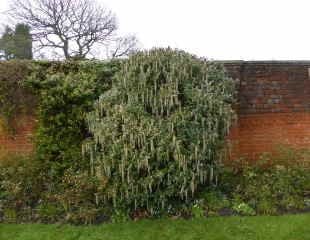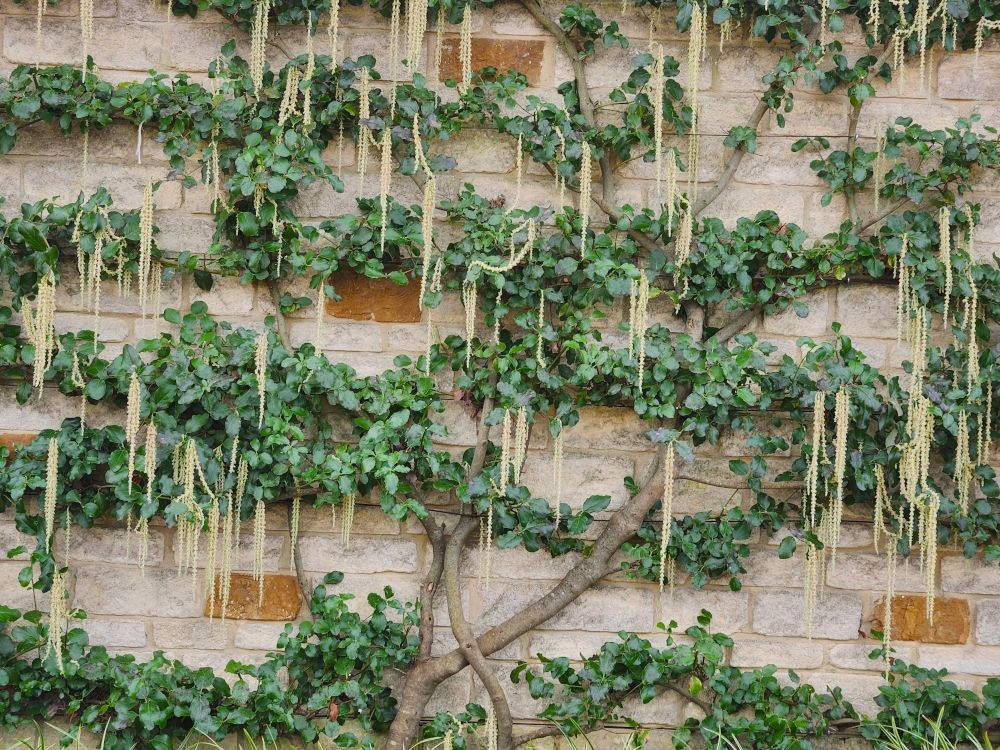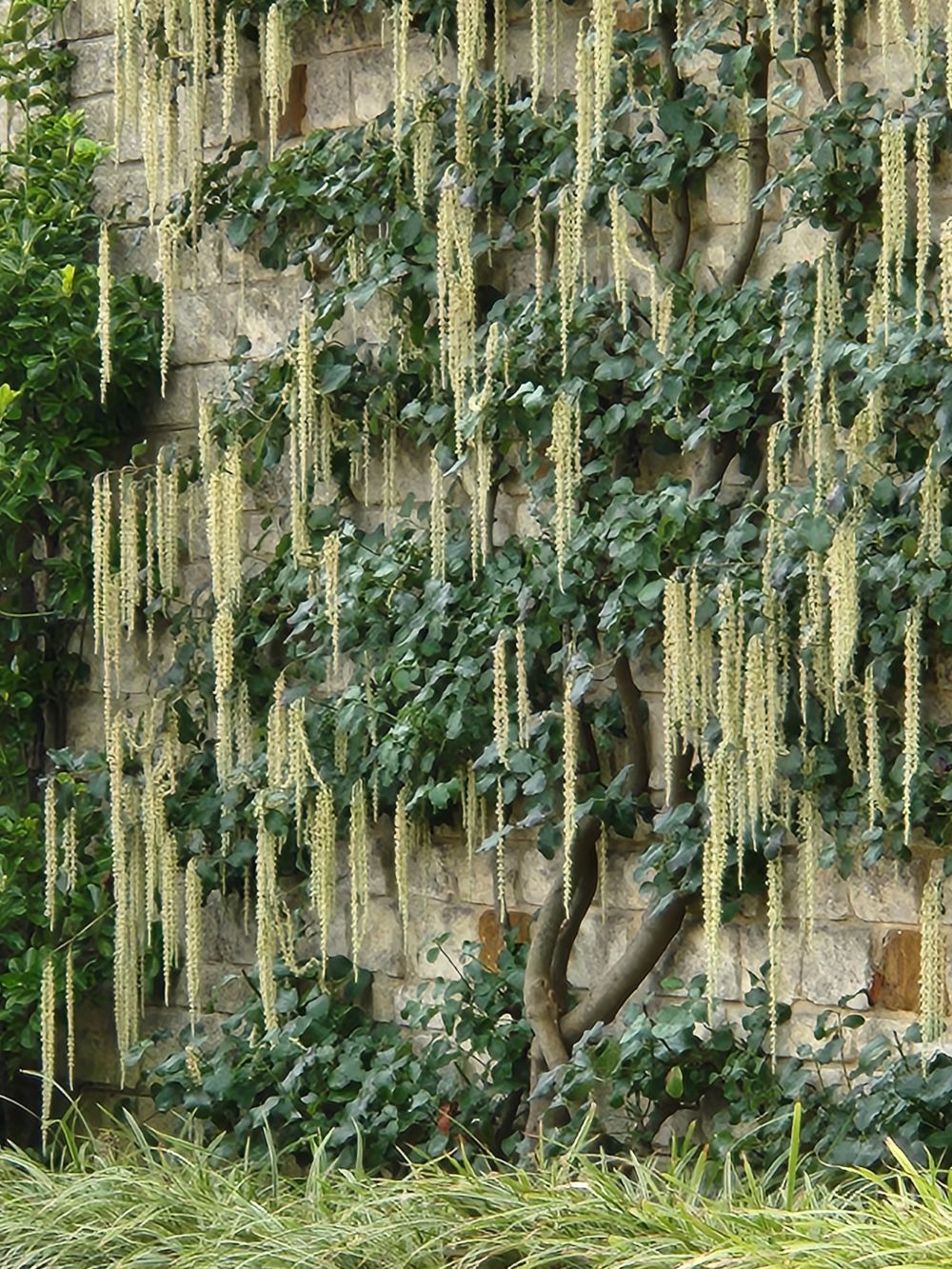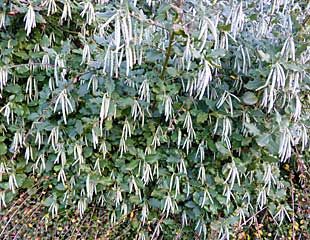
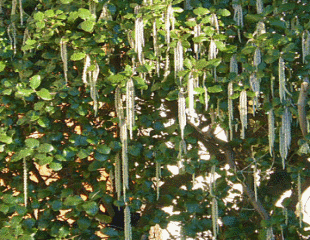
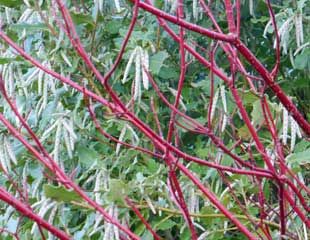
How to grow Garrya elliptica common name Silk Tassel Bush

Garrya is an easy to grow, evergreen shrub which has long attractive catkins, or tassels from December through January & February. This gives rise to its common name 'Silk Tassel Bush'. Not all varieties of Garrya are fully frost hardy, G. elliptica, which originates from California, is classified as H4 hardy in more sheltered areas and costal gardens.
Despite this classification, I have seen Garrya growing successfully in some fairly cold areas, such as part of landscaping around a Co-Op shop in the Pennine area. The preferred growing conditions for Garrya are a sheltered spot away from cold winds, but clearly Garrya will grow in colder areas.
Garryas will also tolerate salt winds and is suitable for a coastal garden.
If Garrya is not suitable for your garden for more ideas, check out Fast Growing Evergreen shrubs, Spring and Summer flowering shrubs and other shrubs with Autumn and Winter interest.
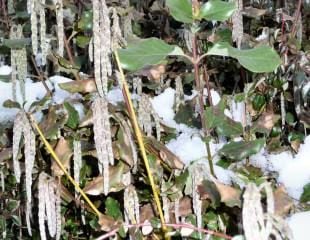
Garrya is suitable to grow in most soil types, including moist soil and in semi shade. It is best planted in a sheltered spot, as exposure to cold winds can cause wind scorch (image left) which will brown the leaves. Garrya will grow to around 2 - 3m, (6.5' to 10') larger in a good growing conditions. Garrya elliptica is ideal to grow against a wall to provide shelter and to display the catkins, see below.
Garrya grows at a medium rate and it will take up to 20 years to reach full size and maturity, which is around 4 meters.
Immature Garrya with tassels

I couldn't resist taking this image which I spotted growing in someone's front garden.
Despite its obvious immaturity, the shrub is already producing tassels nearly as large as itself.
If you are buying a shrub for a particular feature, such as a Garrya for its tassels, a good idea is to buy it when the tassels should be on the shrub. Then you can see what they are like, and if it's what you want.
This applies equally to other shrubs, such as if you want a wisteria to flower start with a plant which is in flower, then at least you know it can flower.
Varieties of Garrya to grow
Garrya is an ideal wall shrub. It is hardy to -10, but it thrives in the shelter of a wall and produces great tassels.
Although both male and female plants have catkins, the male plants have the best catkins and it is strongly recommended to buy a male shrub. G. elliptica has tassels up to 15 cms long. G. 'Evie' is male with long catkins up to 30cms.
The most commonly sold and seen in the UK is G.'James Roof' with dark green leaves and a profusion of catkins up to 35cms long ( if growing conditions are ideal,) making it an attractiveshrub for winter interest. G James Roof has the RHS award of garden merit.
There is a variety G. x issaquahensis 'Pat Ballard' which has slightly mauve tinged catkins and G. x issaquahensis 'Glasnevin Wine' with reddish catkins, although these are less commonly grown. Both have very attractive catkins, well worth growing, but hard to find in garden retail outlets.
Buy Garrya elliptica 'James Roof' from Crocus (affiliate link)
Garrya as a fan trained wall shrub
Garrya looks impressive when fan trained on a wall. I took this image when I spotted a Garrya elliptica, almost certainly 'James Roof', in full tassel bloom in February.
Training as a fan really shows off the tassels to their best.
To create this fan effect, it is important to prune correctly from when the shrub is first planted. Garrya is not self clinging, it will need a framework of hooks, or eyes and wire to train the branches along.
In this image left, you can see the wires and support framework in the background of the shrub.
In addition to wires, you can strengthen the framework by bamboo canes placed horizontally and tied in to support the branches, creating a ladder shaped framework.
Buy a young plant and cut it back so there is just one, or preferably two, branches and remove the rest. Train the first two branches in opposite directions along the wires/bamboo poles to create the lower layer.
Prune off any unwanted growth and with the next two strong branches, train these along the next rung or layer to create the fan effect. The second images show the end result after some mature growth.
Keep training the branches out to form arms, or a fan shape. By spacing the wire framework with regular even gaps, when you train the branches outwards, you will achieve a balanced look.
This image shows the full effect of a mature shrub, and the tassels are highlighted.
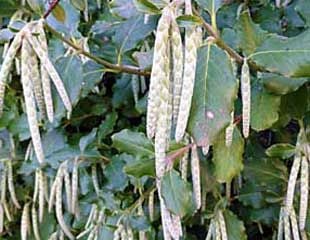
How to prune Garrya
Garrya needs no maintenance or regular pruning. If the shrub has been damaged by a bad winter, you can remove the browned leaves by pruning.
Avoid hard pruning of Garrya. This means it is difficult to contain the size of the shrub by pruning. It is best grown where there is enough space to accommodate it as a large shrub. Garrya is pruning group 8 which refers to evergreen shrubs which flower between winter and early spring, on the previous year's growth.
The plant forms its late winter tassels over the previous months, making it important to prune only after the tassels have finished. Pruning earlier will risk cutting away the wood on which the tassels are forming and miss a year's flower. You can tidy up Garrya to remove dead branches and create symmetry.
As the images show, Garrya is an eye-catching shrub and which looks great in the winter. It combines well with other winter shrubs such as Cotoneaster horizontalis and with Cornus both with red stems (above right ) C, alba 'Sibirica'and yellow stems (below right), C. sericea Flaviramea.
The Tassels are interesting, viewed in close up as the images below illustrate.
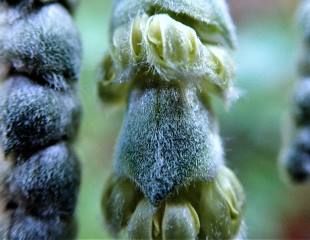
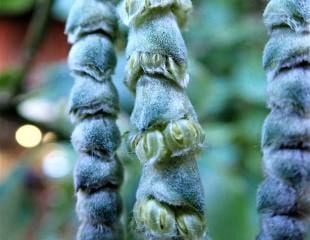
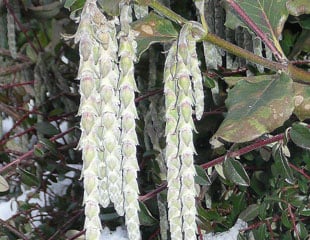

Garrya elliptica is an easy to grow shrub, low maintenance and reliable.

